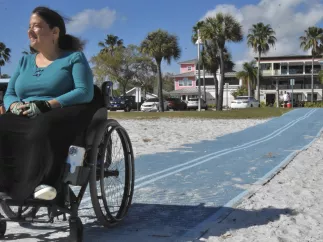Museum Accessibility in St. Pete-Clearwater
St. Pete-Clearwater offers museums and other attractions so unique that they just might be the highlight of your Florida vacation. Read our accessibility guide to help you enjoy the experience fully.
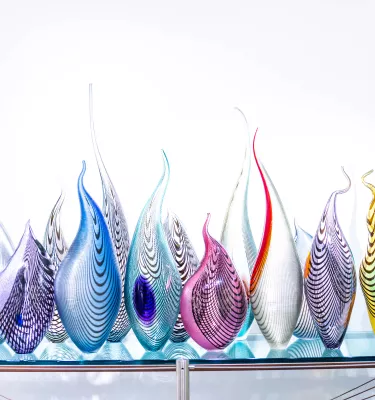
Wonderful works of glass art – like this piece found at Imagine Museum – are a key part of St. Pete's flourishing art scene.
Expert Insights
We wrote this article about local museums with the help of Beth Stombaugh, who is a manual wheelchair user. In early 2023, Beth visited museums and other attractions in St. Pete-Clearwater to provide firsthand insight on accessibility. Since then, she has helped update this information several times a year. When she’s not advocating for the rights of people with disabilities, this resident of Gulfport, Florida, is exploring local parks, taking photos of wildlife, and singing in St. Pete's One City Chorus. Before retiring, Beth was a special education teacher in Ohio for 24 years.
Also see our guides to Accessible Beaches, Accessible Parks and Attraction Accessibility – other projects that Beth contributed to.
Updated June 2025
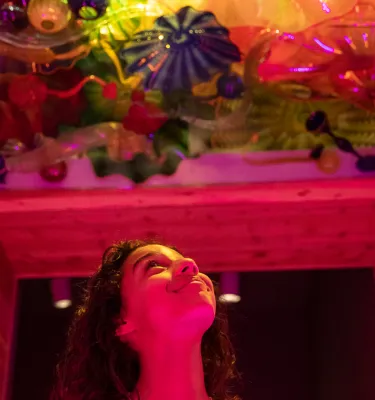
The Chihuly Collection's fantastical glass art is a can't-miss experience.
The Chihuly Collection
The Chihuly Collection is a colorful explosion of creative glass art created by Dale Chihuly himself, as well as talented artists who work with him. It's a can't-miss museum experience in St. Pete.
- Beth’s comments and tips: “The glass sculptures at the Chihuly were magical to see. The bright colors and reflections the glass created were captivating! Note that the price of admission also allows you access to the Morean Glass Studio and Hot Shop, where you can watch glassblowers create pieces of art.”
- Parking and access to the building: The museum has no dedicated parking lot or garage, but there is street parking with a few disability spots. It may be hard to find a spot at times. There’s an access button to enter the building. You could also consider parking in the lot near the Morean Glass Studio, across the street.
- Details about exhibit access: Beth notes that there is good access with wide aisles throughout the building, and that it's easy to see the glass art while seated.
- Bathrooms: The door to the bathroom is fairly heavy. There is an ADA-compliant stall with a sink.
- Loaner wheelchairs: Manual chairs are available.
- Accommodations for people who are sight- or hearing-impaired: There’s a QR code you can scan to hear audio descriptions of the artwork. Touch tours for visually impaired are available, call to schedule.
- Other facility details:
- Benches are available in the museum for guests. The gift shop has wide aisles, and most items are within reach for people in wheelchairs. Caregivers are admitted free if a museum guest needs assistance.
- An audio tour both in Spanish and English is available and Distract Packs for children on the Autism spectrum are available at the front desk. The packs can be used at both the Chihuly and Morean Arts Center.
- Monthly "memory mornings" private tours are available for individuals with dementia or Alzheimers and their caregivers. Call for dates and to reserve.
Morean Arts Center
This small-but-lovely spot just across from the Chihuly Collection is a nice place to peruse a variety of art genres and mediums – and, even better, it’s free. The center also offers classes for adults and Saturday art activities for kids.
- Beth’s comments and tips: “The art here is mostly by local artists, and it changes frequently. The center is all on one floor and isn’t large, so it would be easy to see all of the artwork even if walking long distances is difficult for someone.”
- Parking and access to the building: There's a parking lot by the center with free disability parking spots. It’s about 75 yards from the parking lot to the building. There is a sidewalk with curb cuts and a flat entrance to the building.
- Details about exhibit access: All of the exhibits are accessible for a person in a wheelchair.
- Bathrooms: The entry door to the bathroom is moderately heavy, and there is no access button. There is an ADA-compliant stall with a sink.
- Loaner wheelchairs: Loaner wheelchairs are available at Chihuly.
- Accommodations for people who are sight- or hearing-impaired: All of the art descriptions are in visual form.
- Other facility details:
- The Banyan Tree restaurant is attached to the Morean Arts Center. You order at the counter, and a server brings the food to you. There is indoor and outdoor seating with low, accessible tables.
- The center offers classes to the public. Accommodations are available – contact the center ahead of time.
- An audio tour both in Spanish and English is available and Distract Packs for children on the Autism spectrum are available at the front desk. The packs can be used at both the Chihuly and Morean Arts Center.
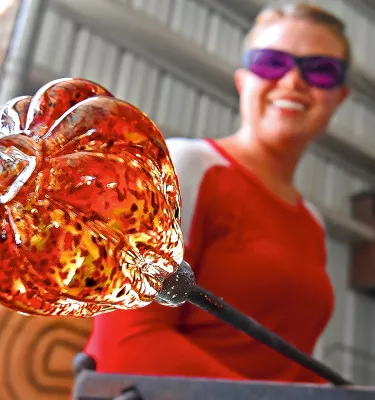
You can get hands-on with demonstration artists at the Morean Glass Studio.
Morean Glass Studio & Hot Shop
It's not every day that you get a chance to see a beautiful piece of art being created right before your eyes, but the Hot Shop is just such a place. Visitors can also sign up for a glassblowing experience to create a small piece of glass art themselves, with the help of experienced glassblowers (separate fee). Admission to the Hot Shop is free with a ticket to The Chihuly Collection. The adjacent Glass Studio is open to the public at no charge, though you may be tempted to spend some cash on a unique souvenir.
- Beth’s comments and tips: “The Hot Shop experience was narrated and very informative. It was fascinating to see! The artists were very willing to answer questions after the demo. The glass studio is fairly small and can become a bit crowded – but it’s worth seeing.”
- Parking and access to the building: There’s street parking and also a lot next to the Morean Arts Center and Glass Studio that has free disability parking. It’s approximately 75 yards from the parking lot to the building. There’s a flat entrance into the Hot Shop, and a flat entrance into the Morean Glass Studio from there.
- Bathrooms: The Hot Shop has no bathrooms, but the Morean Glass Studio has an ADA-compliant stall with a sink.
- Loaner wheelchairs: Loaner wheelchairs are available at the Chihuly Museum across the street.
- Other facility details:
- The Hot Shop has stadium-style seating, but there’s space in the front for wheelchairs. This provides a very good view of the glassblowing demonstrations.
- Note that the Hot Shop will be very warm in the summertime due to the Florida weather combined with the heat from the furnaces.
- The Glass Studio has many items for sale, and most have easy access for people in wheelchairs. Employees are available to assist with picking up fragile or heavy glass items.
- Operation Art of Valor for veterens with TBI or PTSD allows individuals to participate in free glass blowing on Sundays. Call the Hot Shop or the Chihuly for times and to schedule.

The Enigma, part of the Dalí Museum's exterior, reflects the clouds and blue sky in its geodesic dome.
Salvador Dalí Museum
This mind-blowing collection of surrealist works by the famous Spanish artist is housed in an equally fascinating building. Special exhibits enhance a visit to this landmark museum in St. Pete.
- Beth’s comments and tips: “The architecture of the building is spectacular. The special AI exhibit was very interesting.”
- Parking and access to the building: "There's a parking lot next to the museum. It looks like they have painted over some of the accessible parking spaces, so all of the spots were full on my visit. I had to park in an end spot in an adjacent lot for $10. It's between 50 and 200 yards from the parking to the building, depending on where you park." There are no access buttons to the entrance, however, a museum employee who checks bags will open the door for you.
- Details about exhibit access: All exhibits are accessible. However, the permanent collection galleries can become crowded and difficult to maneuver through if the museum is crowded. Come early, if possible.
- Elevators: The elevators are large and have Braille on the buttons.
- Bathrooms: On both floors, there is an ADA-compliant bathroom. There's also a gender-neutral ADA-compliant bathroom on both floors. The entry doors to the bathrooms are fairly heavy.
- Loaner wheelchairs: Manual wheelchairs are available.
- Other facility details:
- The auditorium has wheelchair-accessible seating in the back and closed captioning.
- There is a cafe where you can order at the counter, and they bring the food to you. There is accessible seating inside the cafe as well as outside in the garden area.
- For visitors who are on the autism spectrum, the website offers a museum experience book to download. In addition, the museum offers "Sensory Sundays" from 10 a.m. to noon (one Sunday each quarter; check with museum for specific dates). There is also a quiet contemplation room available.
- All visitors may download free audio content on the museum's app. In addition, there are docent-led tours, large-print info books and a limited number of induction loops available to use with hearing aids.
- An ASL interpreter can be available if you call the museum two weeks in advance of your visit.
- There are full-page magnifier devices available for loan.
- Guests who experience color blindness may borrow a pair of Enchroma glasses at the museum.
- There is no button access for the emergency exit door.

Peacocks like the one on this 1910 panel are a feature you'll see often at the Museum of the American Arts and Crafts Movement in St. Pete.
Museum of the American Arts & Crafts Movement
St. Pete’s newest museum is the only one in the world dedicated solely to the American Arts and Crafts movement, focusing on skilled craftsmanship and the beauty of the natural materials used to create furniture and other home goods.
- Beth’s comments and tips: “I loved the architecture of the museum. It was great to see so many female artists' work displayed. The views of St. Pete from the expansive windows were beautiful! Note that docent-led tours are available, or you can download the app to hear the audio for a self-guided tour.”
- Parking and access to the building: There are a few disability parking spots in the parking lot next to the museum. There’s also a parking garage with disability spots, but you must be able to reach to put a credit card in the machine to park there. There is an access button at the main entrance.
- Details about exhibit access: There are wide aisles throughout the museum, making it easy for wheelchair users to maneuver throughout. Signs for the collection pieces are all visual. However, you can download the museum’s app to hear audio descriptions. In the Pottery Gallery, some of the pieces are placed too high for a person in a wheelchair to see the designs. In the Composition Gallery, there are easels where people can sit and draw – however, these are not accessible to visitors in wheelchairs.
- Elevators: There are elevators in the garage, and then you can exit outside to the museum via a flat surface. Inside the museum, the elevators are large, and there is audio telling you the floor number, as well as Braille on the elevator buttons.
- Bathrooms: On each floor, there is a very heavy door to enter the bathrooms, which each contain an ADA-compliant stall with a sink.
- Loaner wheelchairs: Two manual chairs are available.
- Other facility details:
- There is a low, accessible water fountain near the restrooms.
- There are low benches in every gallery (which may present a challenge in getting up for some visitors).
- The gift shop offers good accessibility with wide aisles.
- There is a café where you may order at the counter, and the food is brought to you. Tables are spaced well apart, and it’s easy to pull a wheelchair up to a table.
- The theater has bench seating with no rows or spaces set aside specifically for wheelchairs (visitors in wheelchairs would need to be in the back or in the very front of the theater).
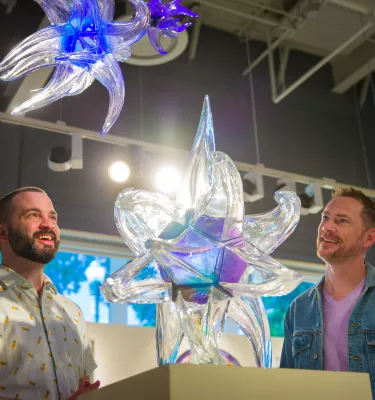
Watch how the glass art at the Imagine Museum seems to dance with light.
Imagine Museum
This stunning center for contemporary glass is one of the mainstays of St. Pete’s “Glass Coast” art scene. Plan to spend two or three hours enjoying the permanent collection and special exhibits.
- Beth’s comments and tips: “Beautiful galleries! And very helpful staff. Overall, very good accessibility. Full-time caregivers get in free with a person who has a disability. There is a docent-led tour every day at 3 p.m. Plus, the museum now has closed captioning on all TV monitors in the museum. Note that this museum may not be suitable for visitors with young children who will want to touch the glass art.”
- Parking and access to the building: Three disability parking spots with access stripes are located in the parking lot next to the museum. The spots are about 50 yards from the building, and access is via a sidewalk. There is an access button for the door.
- Details about exhibit access: The exhibits primarily have written descriptions (no Braille), and an audio tour is available. The boat exhibit on the second floor is too high for a person in a wheelchair to see inside.
- Elevators: Beth said there isn’t much room for someone in a large scooter or electric wheelchair to turn around.
- Bathrooms: On the first floor, the outside bathroom door has no button, and the door is very heavy; there is an ADA-compliant stall. On the second floor, the outside entry door is very heavy. There is an ADA-compliant stall with a sink inside.
- Loaner wheelchairs: Two manual chairs are available.
- Other facility details:
- The water fountain on the second floor is low and accessible.
- There are benches for visitors who would like to rest (a sign says there is a 250-pound weight limit, however).
- All emergency exits have push buttons.
- In the theater on the second floor, there’s plenty of room for wheelchairs.
- The gift shop is very accessible, with wide aisles.

The Florida Holocaust Museum in St. Pete displays heartbreaking artifacts, such as this wooden boxcar used to transport Jews to concentration camps.
Florida Holocaust Museum
This thought-provoking museum depicts the social, religious and economic factors that helped set the stage for one of the world's greatest tragedies, and displays artifacts that bring the victims' stories to life. The museum has recently reopened after an extensive renovation. Our expert has not had an opportunity to visit since the museum reopened, but we'll post new information about accessibility as soon as possible.
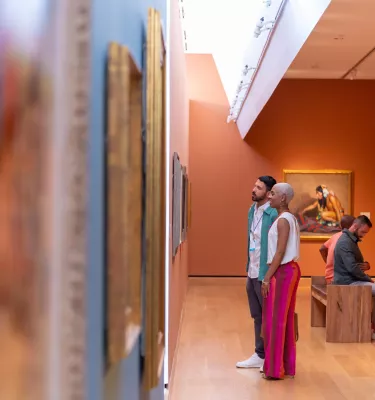
Paintings at the James Museum depict perspectives of Indigenous peoples in the American West.
The James Museum of Western & Wildlife Art
This expansive collection of Western and Native American art offers visitors an opportunity to learn more about the history of the American West and its people.
- Beth’s comments and tips: “There's a wide variety of art in many mediums. The museum is very spacious and accessible; it doesn't feel crowded.”
- Parking and access to the building: There is disability parking on the third and fourth floors of the SouthCore Parking Garage. The first hour is free, then it's $1 per hour. During Beth's visit (around noon on a weekday), there were no garage spots available so she parked on the street and took the sidewalk and ramp up to the entrance. The ramp is concrete and the door opens automatically. It's very accessible.
- Details about exhibit access: All of the exhibits are very accessible to mobility-impaired people.
- Elevators: The elevators are large with rails around the sides and Braille on the buttons.
- Bathrooms: There is a gender-neutral, ADA-compliant bathroom. To open the door, all you need to do is wave your hand in front of a button, and the door opens to a large room with an ADA-compliant bathroom with a sink. To turn on the faucet, you wave your hand. There are also gender-specific restrooms with ADA-compliant stalls, however the door to enter is fairly heavy.
- Loaner wheelchairs: Manual chairs are available.
- Other facility details:
- There are benches throughout the museum. In the movie area, there is ample seating for wheelchair users, and the movie has closed captioning.
- There is a "social story" card available for people with autism or sensory processing disorder; the link also contains tips for caretakers.
- The museum offers free admission to some groups as well as to people who have an EBT card.
- There is a cafe that has low tables. You order at the counter, and they bring the food to you.
- The emergency exit has no access buttons or automatic opener. However, Beth noted that the entrance and the bathrooms in this museum are the most accessible of any she has visited.
- Special programs: The James offers a program called "Art in Mind," with tours given by specially trained docents for visitors with dementia or Alzheimer's. Four times a year, the James offers a sensory-friendly morning for people who have ASD or who are neurodivergent (reservations are required). Call for dates and to schedule a visit.
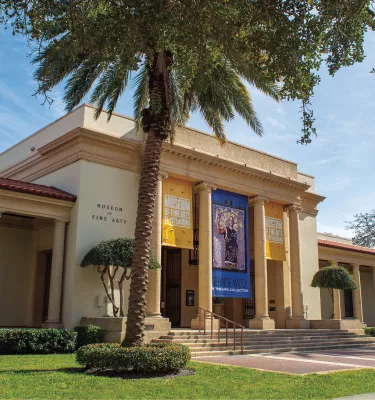
A short distance from the St. Pete Pier, the Museum of Fine Arts offers an extensive collection of artwork in beautiful galleries.
Museum of Fine Arts St. Petersburg
This fine art museum's collection is impressive. Expect to spend most of the day here if you want to see everything. The museum's cafe is a nice break from all of the art-gazing, and it offers views of the sparkling St. Pete waterfront.
- Beth’s comments and tips: “If you need special accommodations for your visit, it would be wise to spend some time on the museum's accessibility page."
- Parking and access to the building: The parking lot by the building has one disability spot. It was occupied when Beth visited, so she parked across the street from the museum in a free disability spot. There's a long ramp up to the entrance, and then automatic doors (no button is needed). However, on the day Beth visited, the doors didn't open all of the way; someone in a larger chair would have needed assistance to enter.
- Details about exhibit access: All of the art is easily viewable in the museum; the aisles are wide. The largest rooms in the museum have benches; some smaller rooms do not. One movie did not include closed captioning. The outside sculpture garden and courtyard area did not offer easy access to a person with a mobility impairment (the doors outside were very heavy with no automatic buttons).
- Elevators: The elevators were easily accessible.
- Bathrooms: Each floor has an ADA-accessible stall within the main bathrooms. In addition, each floor has a large, ADA-compliant, gender-neutral bathroom; this bathroom would be the best to use if you need more space or assistance from an attendant.
- Loaner wheelchairs: Manual wheelchairs are available.
- Other facility details:
- At the time of Beth's visit, there were no special presentations scheduled, but she noted that there is accessible seating available, as well as assistive listening devices. Headphones are available for purchase for iLoop connection.
- There's a small gift shop in the main lobby that is accessible, with adequate spacing between shelves and displays.
- At the on-site Cafe Clementine (open 9 a.m. to 3 p.m. Thursday through Sunday), you may order at the counter and pay there, and a server will bring your food to you. There is cafe seating both inside and outside.
- The museum is autism-friendly: Fidget objects and noise-canceling headphones are available at the front desk. The museum's website also offers a sensory guide to provide details about how much visual, noise, touch and smell stimulation can be expected, as well as information on which rooms may be more crowded. Some Saturdays at the museum are "Sensory Saturdays," where all known triggers are off. On any day, the sculpture garden is a good place for guests who need a break or some quiet (however, guests in wheelchairs may need assistance to access it).
- There are many visual signs available in the museum, as well as docent-led tours. ASL tours are available if scheduled three weeks in advance (call 727-896-2667).
- For color-blind or low-vision guests, free color-enhancing glasses are available at the front desk.
- The emergency exit doors do not have an automatic button opener.
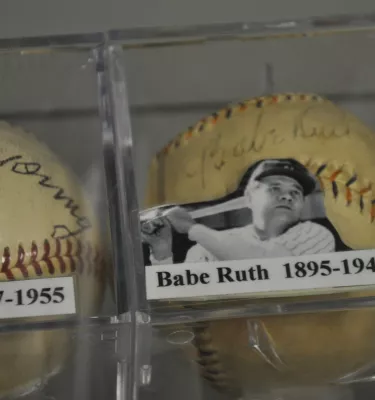
See the largest collection of signed baseballs in the world at the St. Petersburg Museum of History.
St. Petersburg Museum of History
This small museum has a quirky and entertaining collection that ranges from a re-creation of the Benoist (the world's first commercial airliner) to Schrader's Little Cooperstown (housing the largest collection of baseballs in the world). It's also a good place to see vintage Floridiana and learn about St. Pete's early history.
- Beth’s comments and tips: “If you like baseball, they have many autograph baseballs available to view. The museum is very close to the St. Pete Pier."
- Parking and access to the building: The parking lot next to the museum has disability parking spots. Visitors must pay for parking at an automated kiosk, which could be difficult for some guests who have limited hand function. From the lot, there is a sidewalk and concrete ramp to approach the museum. The entrance doors don't have access buttons and are fairly heavy.
- Details about exhibit access: All of the exhibits are accessible, but some of the signage is a bit high for a person in a wheelchair, and the print is small. There are a few steps to get into the St. Pete Pier exhibit, but you can enter through another door to get in. In one area of the museum, TVs show old newscasts and other footage about St. Pete history (closed captioning was not available). There are no audio descriptions available for any of the exhibits; everything is visual. The museum plans to start docent-led tours soon.
- Loaner wheelchairs: There are no wheelchairs available at the museum.
- Bathrooms: The entrance door to the bathroom was heavy. There is an ADA-compliant stall inside.
- Other facility details: There are no elevators, as everything is on one floor. The emergency exit door is not very accessible and has no access button.

